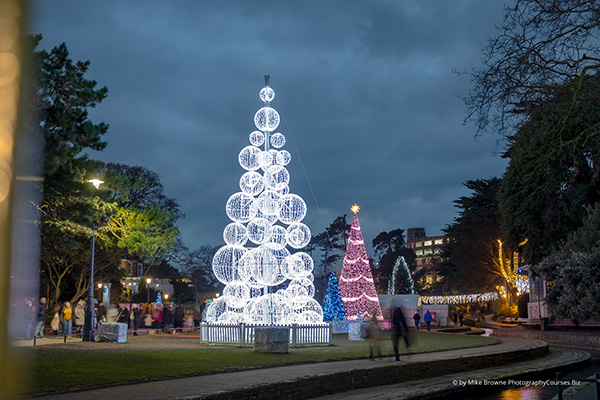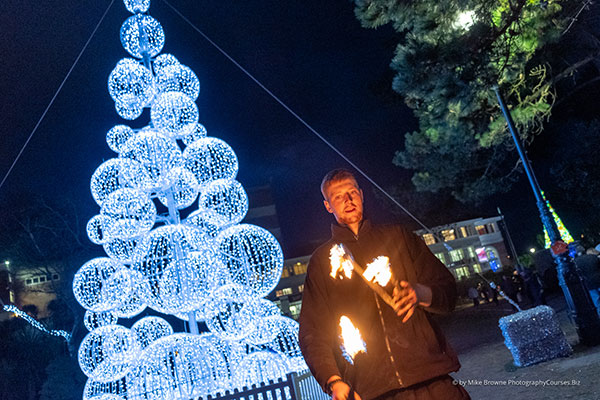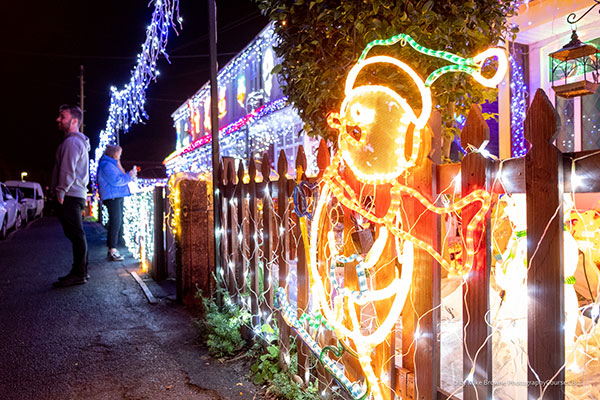Sparkly Christmas Night Shoot
If you enjoy night photography, Christmas presents a perfect opportunity to grab your camera of an evening and get stuck in. People are usually full of ‘good will to all mankind’ cheer, which is great if you want to incorporate a bit of street photography with all the sparkly lights.
A wide aperture lens and camera that performs well at high ISOs is an advantage, but by no means a necessity. I used my Fuji XT-2 and standard 18-55mm as I usually do - for everything! And if you’re thinking your camera is only an entry level one - it doesn’t matter. You just need to think it through, ask yourself what you want and need, then take appropriate actions to get it.
Come on, let’s have a Q&A session about night photography
Q: What’s likely to happen to the shutter speed?
A: It’ll be slow because light levels are low and images will probably blur through camera shake and / or subject movement
Q: So what can you do about that?
A: Use a tripod so the camera can’t move and high ISO to minimise subject movement (unless you want movement in the subject like I did with the passers by in this shot)

Q: I don’t have a tripod so what can I do?
A: Increase ISO and aperture until the shutter speed is fast enough the image doesn’t blur.
Q: High ISO lowers image quality, so how high is it safe to go?
A: All cameras are different so test yours at high ISOs before you go so you know what you can get away with. (Personally I’d rather have a sharp image with noise / grain, than a blurry soft useless one.)
Q: Which metering mode is best for night photography?
A: Whichever you’re most familiar with. I recommend matrix / evaluative metering so it averages bright and dark areas together. (Remember, camera meters are not infallible and what it suggests is only a starting point. Check your histogram and adjust exposure until the clipping at either end is minimised.)
Q: Which shooting mode is best?
A: Any mode that allows you to adjust exposure. Not full auto. (If light levels are not changing, I recommend manual mode because once you have a good exposure for a location you don’t need to change or think about it again and can concentrate on shooting the image until the next location - when you’ll have to check exposure anyway.)
Q: Which focal length should I use?
A: The one that gives you the look you want and won’t magnify camera shake beyond the ability of the shutter speed you’re using to freeze it.
Q: What else do I need to do?
A: Concentrate on what’s going on around you, find interesting images, compose and shoot.
When you know how to control the camera and think your shots through, technically that’s all there is to it. Now you can concentrate on photography instead of settings because settings don’t give you photos - photos give you settings...
Decisive moments
If all your brain is entirely taken up with wondering how to set up the camera, you’ll miss opportunities and the little magic moments that make images interesting, regardless of what genre you prefer. It could be a momentary shaft of light between the clouds, a wave breaking or receding, a fleeting glance or expression….
Q: What do you think would have happened to the light on the jugglers face if the shutter was pressed one second earlier or later?

A: If the fire sticks were all lower, there wouldn’t be enough light on his face and he’d be underexposed.
And don’t forget expression. It’d be all too easy to expose correctly but capture an un-engaging expression! In the gallery in the video @ 20:22 you might have noticed me crouching over by the fence composing this image in Byron Road.

What you didn’t see was how long I waited like that for someone to do something in the space. I saw these guys slowly walking up the street so I waited to see what would happen. The girl stopped to take a picture, the guy took a few paces more then turned to look the other way - and BOOM. Decisive moment captured. Forethought and patience are not camera settings, but they are vital ingredients for photographers.
Q: Why didn’t you use flash Browne?
A: Personally, I don’t like flash unless it’s totally unavoidable. If it’s not used skillfully to balance the two exposures (and that takes time, effort and is another level of thought to get right) flash can quickly destroy the mood and feel of a place and make it look unnatural.
To shoot this with flash you’d be making 2 exposures at once. One for the flash and another for the available light. Then you have to find a way to blend the flash and available light qualities so there are no hot spots close to the camera, enough light reaching the areas you want it and they work harmoniously together. It’s doable, but you need time and a controlled environment to make it work.
So that’s how I went about this Christmas night shoot and some of the questions I would ask of myself for every image I take. They begin with, How do I want this to look? and... What must I do to make that happen?
First you have to know how to control your camera and make it do what you want, then the photography thought process to make your imagery an evocative, fulfilling reality. If you need help with either of these, click the links, take a look at the courses you’ll find there and try a free sample.
I’d genuinely love to be your photography guide and help you get to wherever you want to go…
Until next time…

PS: If you still think expensive kit = better pictures. Ask yourself if a great musician could get an amazing sound from a basic instrument, then watch this vid of Seasick Steve playing a cheap 3 string guitar from a junk shop...
















































